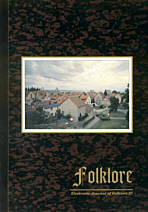Genre Space of Folk Narrative Tradition: The Russian Case
Genre Space of Folk Narrative Tradition: The Russian Case
Author(s): Georgiy A. LevintonSubject(s): Customs / Folklore
Published by: Eesti Kirjandusmuuseum
Keywords: genre space of folklore; Russian folklore; versified vs. non-versified genres; prosaic vs. non-prosaic genres
Summary/Abstract: In this paper I intend to present the “narrative part” of a larger study, Genre Space of Traditional Russian Folklore (or Ethnopoetry, Oral Poetry), which is described in its entirety elsewhere. Two main dimensions (axes, distinctive features) of the space are (a) versified vs. non-versified (verse in Russian folklore, as in some others as well, means sung or recitative performance), and (b)prosaic vs. non prosaic, where prose actually means ‘a story’, i.e., narrative. Thus we have four groups of genres: (1) narrative in verse, (2) non-versified narrative (prose sensu stricto), (3) non-narrative verse (lyrical song, laments)and (4) “neither verse nor prose” (paroemia, spells, etc.).The structure of the two narrative groups is mainly symmetrical; each of them has one nuclear genre, a “main” or most representative genre (fairy tale in non-versified genres, and bylina (epics) in versified ones) and peripheral genres,largely corresponding to each other. The category of ‘spiritual verses’ (dukhovnyie stikhi) corresponds to sacred legends (both being sacral genres), although their repertory of tale types is quite different (e.g., non-versified oral legend includes no hagiographic legends, vitae). Historical songs (some historical ballads as well) share common subject matter with historical legends (istoricheskoe predanie – tales about historical persons). Ballads roughly correspond to novelles (usually called novelistic or Romantic tales, AaTh 850–899), while comic or parody epics resemble the “Jokes and Anecdotes” of Aarne’s classification. For many European traditions I might mention Animal Tales and Animal Epics, respectively, but Russian tradition has no animal epics in verse. Each group has one feature that diminishes as one moves from the nuclear genre to the peripheral ones; in verse genres, this is verse itself. Epics are sung in bylina (epic) verse; other genres combine epic verse and song-verse. In non-versified texts this feature is a stylistic elaboration, with special formulas which can be found to a most sophisticated degree in fairytales and are much less prominent in other genres. Some other types of symmetry connect these genres with non-narrative ones.
Journal: Folklore: Electronic Journal of Folklore
- Issue Year: 2007
- Issue No: 37
- Page Range: 81-90
- Page Count: 10
- Language: English

